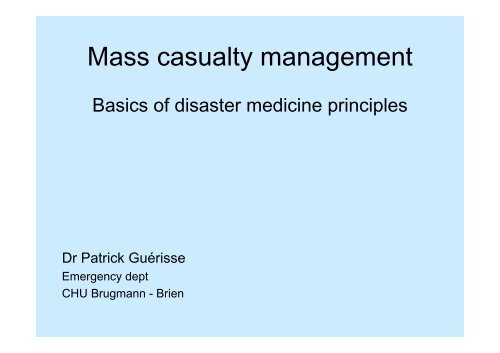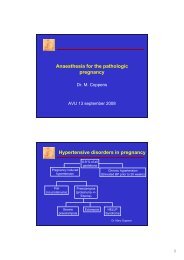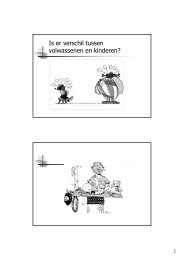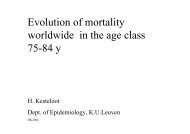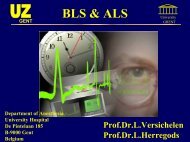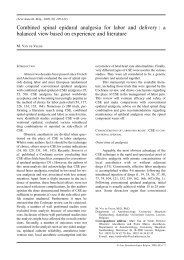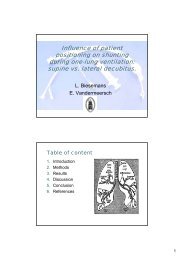Mass casualty management
Mass casualty management
Mass casualty management
Create successful ePaper yourself
Turn your PDF publications into a flip-book with our unique Google optimized e-Paper software.
<strong>Mass</strong> <strong>casualty</strong> <strong>management</strong><br />
Basics of disaster medicine principles<br />
Dr Patrick Guérisse<br />
Emergency dept<br />
CHU Brugmann - Brien
Why disaster medicine ?<br />
Disaster, did you say ?<br />
• « Titanic turn of mind » :<br />
- sinking is unbelievable<br />
- consequently, preparation is useless<br />
•« Zero risk » does not exist :<br />
– Technological accidents :<br />
Seveso (1976), Bhopal (1984), Chernobyl (1986)<br />
– Human accidents :<br />
Football, music festivals, mass gatherings, riots,<br />
terrorism, etc<br />
• Preparedness :<br />
– about <strong>management</strong> much more than medical aspects<br />
– university curriculum open to non medical agencies<br />
– common language
What is a disaster ?<br />
versus a mass emergency or a mass <strong>casualty</strong><br />
• Sudden discrepancy between<br />
- acute needs and<br />
- locally available resources<br />
• Failure for a community to cope with the<br />
consequences of a damage<br />
• Inability of a community to meet the<br />
demand for health care<br />
! Time sensitive definitions<br />
« Disaster » : to be preferred when there is a major disruption<br />
of the social and medical infrastructure
Specificities of a mass emergency<br />
Different from day-to-day practice<br />
Difference of kind and not only of size<br />
Routine emergency<br />
• Well-understood event<br />
• Limited scale<br />
• Easily manageable<br />
• Quickly under control<br />
• Rescuers familiar with<br />
each other<br />
• Well-accepted authority<br />
• Clear-cut roles and<br />
responsibilities<br />
<strong>Mass</strong> emergency<br />
• Enormous problems<br />
• Breakdown of normal<br />
arrangements<br />
• Multiple procedures<br />
• Large number of rescuers<br />
• Unfamiliarity of the agencies<br />
with each other<br />
• Inadequate initiatives<br />
• Conflicting roles and<br />
responsibilities
Preparedness : disaster plan<br />
• Specific plan = organizational framework<br />
• Hazards identification<br />
• Functional job descriptions & responsibilities<br />
• Incident command system<br />
• Tasks and means of action for each agency<br />
• Inter-agency communication protocols<br />
European Community Seveso directive (1982)
The case of Belgium<br />
• Threshold for activation of the disaster plan<br />
– 5 seriously injured<br />
– 10 or more injured of unknown severity<br />
– possibility or necessity of people evacuation<br />
• Automatic response of the rescue-centre ‘100’<br />
– 5 ambulances<br />
– 3 medical teams (SMUR = MUG)<br />
– warning of<br />
• Director of medical rescue on duty (=medical incident officer)<br />
• Red-cross<br />
• Provincial Medical Inspector
On-site immediate organization<br />
1. Giving alarm first<br />
– Accident of unusual size or appearance<br />
– Brief description of the overall conditions<br />
– Asking for activation of the emergency plan<br />
2. Assessment of the number of victims<br />
3. Gathering the victims<br />
4. Establishing a <strong>casualty</strong>-collection point<br />
(PMA – VMP)
Casualty-collection area<br />
( P.M.A. – V.M.P. )<br />
• Mandatory channel for ALL the victims<br />
• Identification<br />
• Triage<br />
• Minimal medical care<br />
• Allocation to appropriate hospital<br />
• Conditions of transport<br />
• Listing
Medical <strong>management</strong><br />
Should victims be brought to hospitals ?<br />
or<br />
should hospitals be brought to the victims ?<br />
• Depending from the day-to-day routine emergency<br />
organization<br />
• Evidence of research indicates that the better way<br />
is to send mobile medical teams to the scene<br />
• Comparison of London and Madrid terrorist<br />
bombings
Why TRIAGE ?<br />
• Conventional standards of medical care cannot<br />
be delivered to all casualties.<br />
As a consequence, medical resources and<br />
personnel must be allotted to provide<br />
the greatest good for the greatest number<br />
( concept of minimal acceptable care )<br />
• The goal is to identify the small number who will<br />
benefit from early scene <strong>management</strong><br />
Consequently, before giving any care,<br />
the first action must be a rapid examination of<br />
ALL the victims one by one,<br />
to identify the most severely injured.
TRIAGE<br />
• Technique for assigning priorities for<br />
treatment of the injured when the resources<br />
are limited (Surgeon general D. Larrey, 1766-1842)<br />
• START system : for first responders<br />
– Binary sort : severely injured and the others<br />
• Mettag tags : for medical teams<br />
– Categorization into groups,<br />
according with the emergency to treat,<br />
i.e. to evacuate to the appropriate facility
Language-free<br />
Serial number<br />
Detachable corners<br />
Name, address<br />
Body diagram<br />
Predominant injury<br />
Vital signs chart<br />
Detachable<br />
priority tabs
Care on the scene<br />
Medical care is limited to lifesaving actions :<br />
B leeding control and<br />
A irway control<br />
S hock prevention<br />
I mmobilization<br />
C lassification
Hospital disaster plans<br />
• Overcrowding of the nearest facility<br />
by spontaneous uncontrolled flights<br />
• Hospital admission capacity :<br />
- different from the number of beds that<br />
can be made available<br />
- the actual bottleneck is the ER and its<br />
capacity to recruit medical teams<br />
• Efficient use of resources :<br />
– appropriate distribution of the casualties from the scene<br />
– only skilled personnel in the ER
The essential of Disaster Medicine,<br />
in a few words …<br />
• Preparedness<br />
• Quickly recognition and warning<br />
• Triage on site<br />
• Minimal medical care = lifesaving actions<br />
• Regulation :<br />
controlled distribution of the injured to<br />
the adequate hospital


